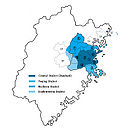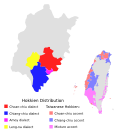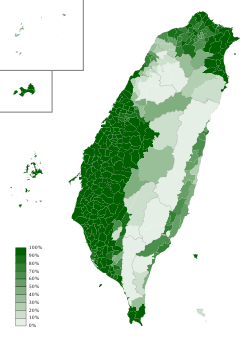Differing literary and colloquial readings for certain Chinese characters are a common feature of many Chinese varieties, and the reading distinctions...
36 KB (2,733 words) - 22:45, 19 May 2025
communication; literary readings are close to modern Mandarin, normally appearing in written language. The literary and colloquial readings have been developing...
15 KB (1,257 words) - 01:07, 24 May 2025
Hokkien (section Literary and colloquial readings)
both literary and colloquial readings: This feature extends to Hokkien numerals, which have both literary and colloquial readings. Literary readings are...
117 KB (10,360 words) - 01:40, 25 May 2025
Fuzhou dialect (redirect from Foochow colloquial)
as follows: The literary and colloquial readings is a feature commonly found in all Chinese dialects throughout China. Literary readings are mainly used...
64 KB (5,132 words) - 03:28, 25 May 2025
in initial, rime and tone: 網 ([mœŋ˦˨] / [uoŋ˧˨]) When there is a difference between literary and colloquial readings, the colloquial one is used in vernacular...
45 KB (4,094 words) - 18:55, 26 May 2025
Amoy dialect (category City colloquials)
complex rules for literary and colloquial readings of Chinese characters. For example, the character for big/great, 大, has a vernacular reading of tōa ([tua˧])...
28 KB (2,616 words) - 21:21, 15 April 2025
On'yomi (redirect from On reading)
"dō" and 泉 "sen". In Chinese, most characters are associated with a single Chinese sound, though there are distinct literary and colloquial readings. However...
9 KB (861 words) - 13:44, 6 November 2024
Kanji (redirect from Onyomi and kunyomi)
literary and colloquial readings of Chinese characters—borrowed readings and native readings. In Chinese these borrowed readings and native readings are...
91 KB (9,169 words) - 09:01, 17 May 2025
Sichuanese dialects (category Pages with non-English text lacking appropriate markup and no ISO hint)
Mandarin, while literary readings tend to resemble modern standard Mandarin. For example, in the Yaoling dialect (摇铃话), the colloquial reading of "物" (means...
32 KB (2,559 words) - 05:53, 2 March 2025
local spoken vernaculars, texts were read aloud using literary and colloquial readings that varied by region. Over time, sound mergers created ambiguities...
121 KB (14,155 words) - 22:40, 31 May 2025
Simplified Chinese characters (category Articles containing Literary Chinese-language text)
characters are referred to by their official name 简化字; jiǎnhuàzì, or colloquially as 简体字; jiǎntǐzì. The latter term refers broadly to all character variants...
60 KB (6,644 words) - 05:28, 31 May 2025
[y] and [u] in Mandarin, along with eastern Shanxi and some Southwestern Mandarin dialects. The existence of literary and colloquial readings is a notable...
30 KB (3,704 words) - 15:47, 24 May 2025
Differing literary and colloquial readings of certain Chinese characters are common doublets in many Chinese varieties, and the reading distinctions...
33 KB (3,325 words) - 08:05, 25 May 2025
set of traditional characters is regulated by the Ministry of Education and standardized in the Standard Form of National Characters. These forms were...
25 KB (2,309 words) - 07:58, 29 May 2025
words, they usually only have native kun readings. However, they occasionally also have a Chinese on reading derived from a related kanji, such as 働 (dō...
10 KB (1,117 words) - 16:36, 24 May 2025
/ˈrɛdɪŋ/) may also refer to: Literary and colloquial readings of Chinese characters Readings of kanji in Japanese Reading (computer), an action performed...
4 KB (530 words) - 20:09, 24 March 2025
Homograph (redirect from Heterography and homography)
Chinese often come into existence due to differences between literary and colloquial readings of Chinese characters. Other homographs may have been created...
11 KB (877 words) - 13:56, 26 May 2025
previous jōyō kanji list. Twenty-eight kanji gained new readings, three kanji lost obscure readings and the kun'yomi of 側 was changed from kawa (かわ) to gawa...
13 KB (1,003 words) - 19:36, 4 May 2025
characters (see Literary and colloquial readings of Chinese characters). The following examples in Pe̍h-oē-jī show differences in readings in Taiwanese Hokkien:...
22 KB (2,593 words) - 18:51, 24 May 2025
Classical Chinese (redirect from Literary Chinese)
additionally developed systems of readings and annotations that enabled non-Chinese speakers to interpret Literary Chinese texts in terms of the local...
28 KB (3,115 words) - 05:46, 13 April 2025
Chinese language (section Old and Middle Chinese)
English alphabet. These have appeared in colloquial usage, as well as in magazines and newspapers, and on websites and television: Since the 20th century,...
84 KB (8,946 words) - 01:05, 3 June 2025
Pinyin (redirect from Pinyin reading material)
Standard Chinese, it is not designed to replace characters for writing Literary Chinese, the standard written language prior to the early 20th century...
72 KB (5,926 words) - 10:09, 6 June 2025
Cantonese (section Hong Kong and Macau)
numerous varieties possess both literary and colloquial readings of Chinese characters for newer standard reading sounds. Since a 1909 decree of the...
98 KB (9,948 words) - 23:14, 26 May 2025
Mandarin Chinese (section Further reading)
China and Taiwan, with minor vocabulary differences. It is the Mandarin variant used in education, media, and official settings. Meanwhile, a colloquial form...
85 KB (8,811 words) - 04:59, 2 June 2025
among non-Mandarin regional languages in having a written colloquial standard, used in Hong Kong and overseas, with a large number of unofficial characters...
39 KB (4,729 words) - 04:23, 24 May 2025
Regular script (category Articles containing Literary Chinese-language text)
Chinese script styles, emerging during the Three Kingdoms period c. 230 CE, and stylistically mature by the 7th century. It is the most common style used...
9 KB (911 words) - 09:17, 13 May 2025
Written vernacular Chinese (section Further reading)
vernacular literature, which excludes certain colloquial forms while incorporating some constructions from Literary Chinese. Similarly, written vernacular Chinese...
19 KB (2,396 words) - 14:00, 7 April 2025
Chữ Nôm (redirect from Nôm reading)
hiragana and katakana. When a character would have two readings, a diacritic may be added to the character to indicate the "indigenous" reading. The two...
68 KB (7,260 words) - 11:02, 4 June 2025
However, literary readings of the numbers are used in certain contexts, such as reciting telephone numbers (see Literary and colloquial readings of Chinese...
103 KB (10,563 words) - 12:57, 31 May 2025
Chinese bronze inscriptions (section Spring and Autumn)
dynasty (c. 1250 – c. 1046 BC) and Western Zhou dynasty (c. 1046 – 771 BC). Types of bronzes include zhong bells and ding tripodal cauldrons. Early inscriptions...
25 KB (3,078 words) - 18:57, 23 April 2025
















